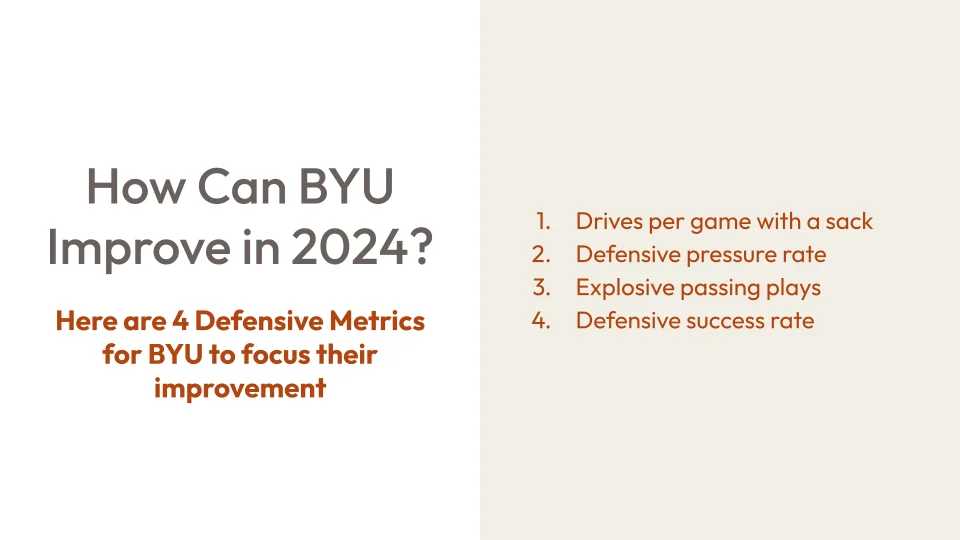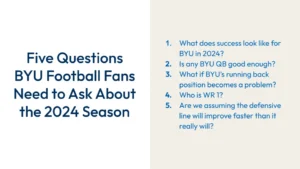I’m excited for the 2024 college football season. Maybe too excited. But then again, can you ever really be too excited about college football? For BYU’s 2024 season, I’m extremely curious to see how the team faces a gauntlet of a Big 12 schedule. A topic for another day, I legitimately could see BYU lose 9 straight games. Then again, the Cougars could surprise me and go 8-4. It was painful to see the Cougars lose 5 straight games to end the 2023 season. So, I’ve been wondering, “How can BYU improve in 2024?” Assuredly they need to, but in what parts of the game?
I’m going to break this down in two parts. Today’s edition starts with the defense. The second edition will be focused on the offense. I am going to skip the special teams because they were good for most of the season (ignoring a punt return for a TD against Texas).
What I have before you is a set of observations that highlight where BYU’s defense needs to improve in 2024. To find these observations, I poured through some typical box score metrics and sliced them differently. I also went through some play by play data and advanced metrics. Then, I used my two good eyes. Not that I have three or four eyes. I only have two eyes, but anyways…
Here are the four areas I’ve outlined that begin to answer the question: “How Can BYU improve in 2024?”:
- Drives per Game with a Sack
- Defensive Pressure Rate
- Explosive Passing Plays
- Defensive Success Rate
To be clear, these are not the only areas of the defense that need improvement, but these categories really stood out to me. For instance, I’m a big believer in defensive success rate. It’s a tricky metric to explain, and it is somewhat boring despite its effectiveness. But, I’ve seen it be a good predictor of points allowed, and last time I checked, you still needed to allow less points than your offense scores in order to get a W.
So, without any further ado, I give you….drum roll please….Four Areas for BYU’s defense to improve in 2024!
RELATED CONTENT
Five Questions BYU Football Fans Need to Ask About the 2024 Season
BYU Football 2024 Schedule Analysis and Expectations
BYU Cougars Season Predictions for 2024
Four areas for BYU’s defense to improve
#1 – Sacks
This is going to be a no brainer for most passionate BYU fans. Before y’all take a look at this metric and say, “that’s obvious! What is this kid telling me that I didn’t already know?”, sit tight. I have a little more detail, and it’s free!
I knew that 2023 was not great in terms of sacks. BYU was tied for the bottom 3 in all of FBS. Not the Big 12. No. All of FBS. And, you could argue that they regressed from last season. In 2022, BYU recorded 13 sacks and was 130th out of 131 teams. So, at this point, there is really nowhere to go but up (although I may have said that last year and the Cougars did go down…)
I wanted to dig deeper though to see how much BYU struggled in 2023. And, when I dug, the picture actually got even worse. First, I looked at sacks in connection with the number of drives defended.
Sacks and Drives Defended
Why would I look at sacks in relation to the number of drives defended? To give the sack volume more context. If BYU had to defend 44 drives on the year, then their 11 sacks would translate to 1 sack every 4 drives. That’s a good number, BUT, that is not the real number. Here’s where it gets ugly.
On the year, BYU defended 146 drives. That was tied for 44th in the nation. A higher drive count could be the result of a high-powered or high-tempo offense. Or, in BYU’s case, it is likely explained by a struggling offense that went 3 and out more often than you would like to see.
That’s 11 sacks across 146 drives. That’s a rate of 1 sack every 13.3 drives. The graph below is ugly, but it must be shown.
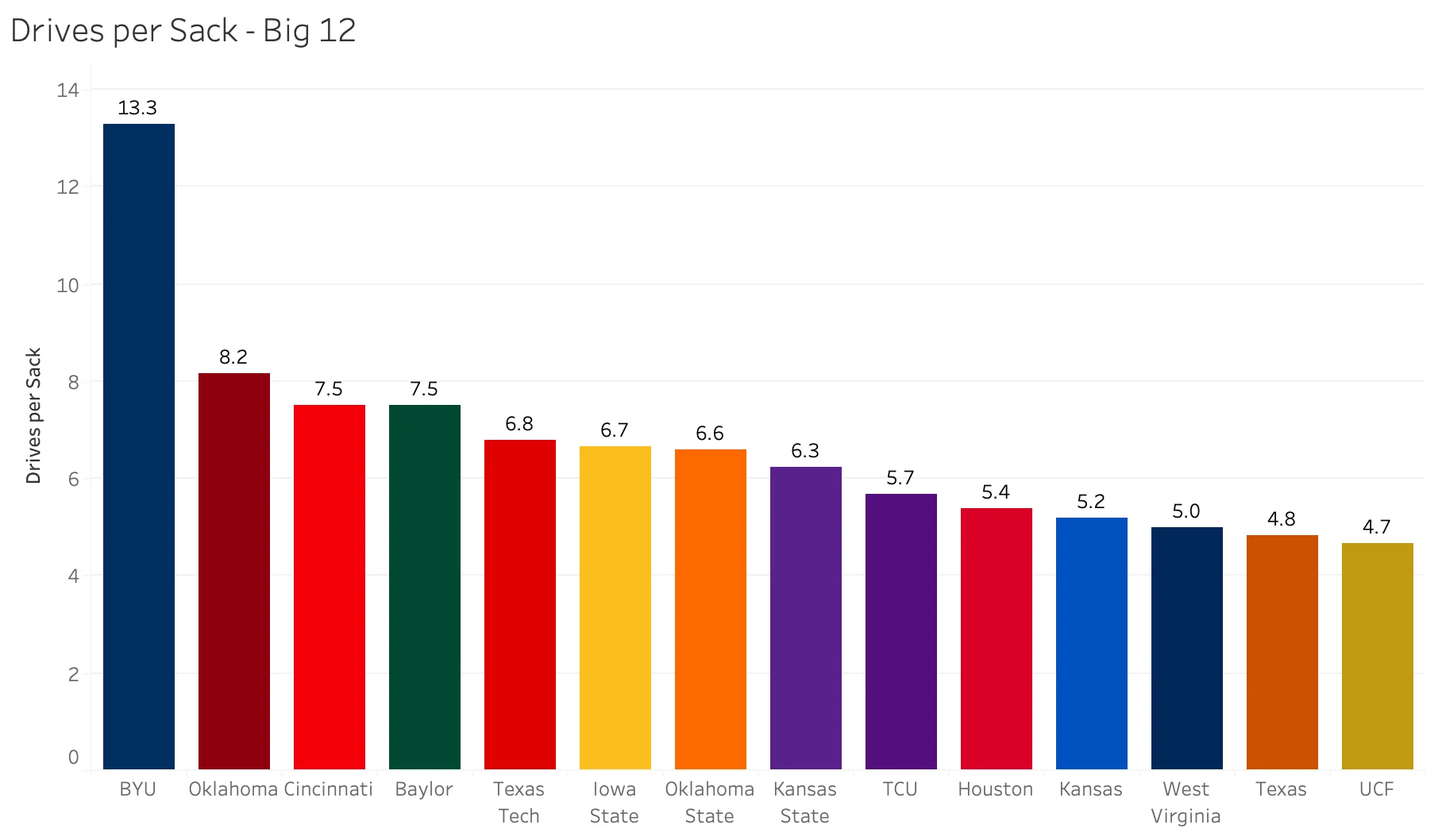
This chart shows the number of drives divided by sacks. BYU was by and far away the worst in the 2023 Big 12. BYU generated 1 sack every 13.3 drives. Most teams average 11 to 12 drives per game. BYU was the only team that wasn’t averaging a sack per game.
Data come from @cfbfastR
Now, BYU had the second worst drives per sack number in the country. And, this next graph shows that there is a small group, which includes BYU, that was particularly bad. BYU, a few teams, and then you see the slide shape of the graph. It is a steep slide. Like one of those really steep slides at the 7-Peaks water park in Provo. (What was it called? Skyscraper?)
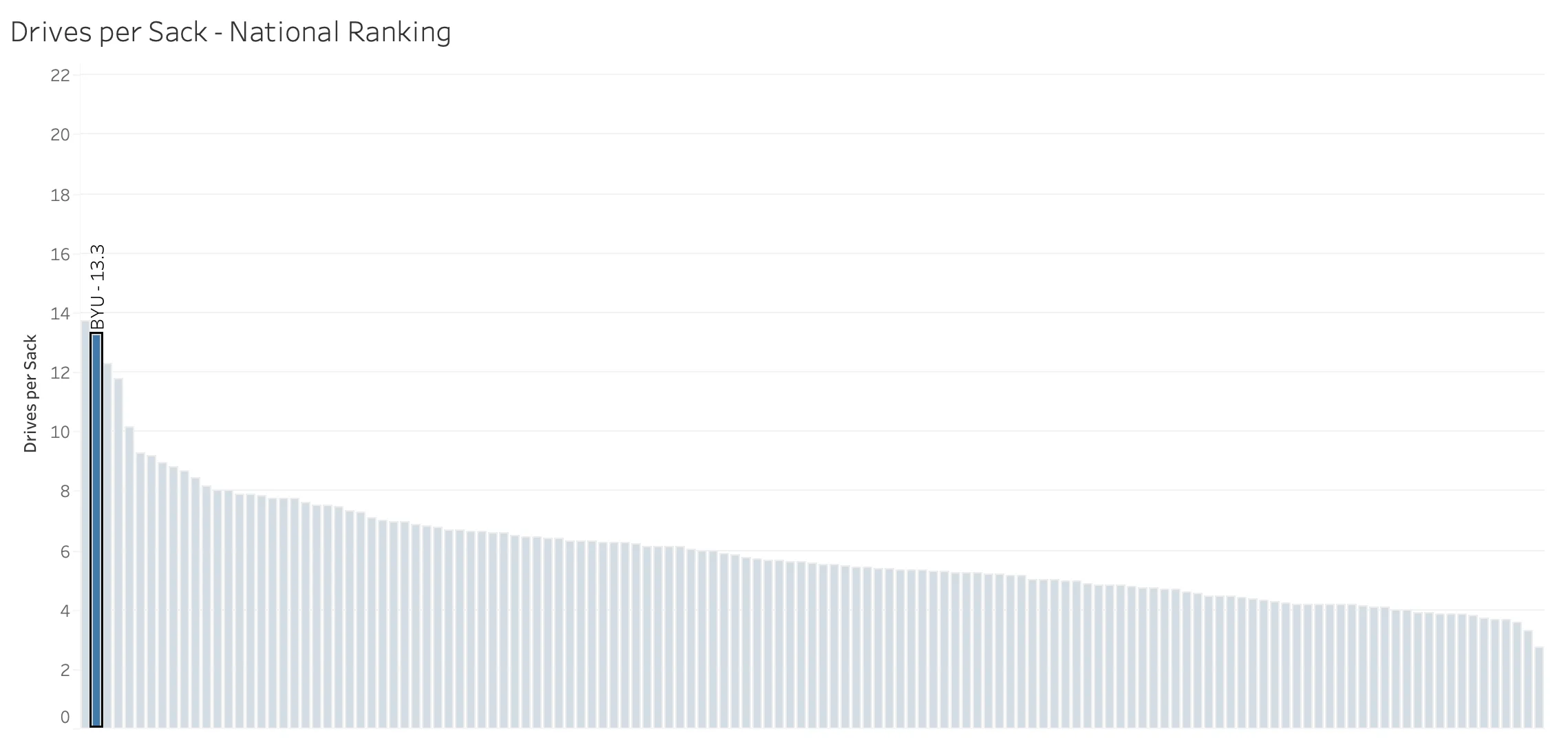
BYU was second worst in the country in drives per sack. There is a clear group of teams, about 5 in total, that were particularly bad, and BYU was among those teams. Drives per sack is one way to adjust for pace or opportunities. In short, BYU needs to generate more sacks.
Data come from @cfbfastR
Percentage of Sacks by the Defensive Line
So, then I said to myself, “Well, how much did BYU’s defensive line contribute to that sack total?” The answer is 73%. They generated 8 of the 11 sacks. Tyler Batty led the team with 5.5 sacks. What do we make of these stats?
Well, the positive is that the defensive line accounted for the bulk of the sacks. That typically means that your corners, safeties, and linebackers are not depended upon as much to get the pressures. Jay Hill’s defense does like to bring the safeties and corners on blitzes, which is why you see that Eddie Heckard had a sack.
The negative here is that the defensive line only generated 8 sacks. That isn’t even 1 per game. I’m going to contrast these numbers with Michigan. If you’ve been following along 3rd Down Analysis and general college football topics, then you’ll see that I’ve started referencing Michigan as a contrast point since late December. That’s because they were really good. Particularly on the defensive line. Possibly the best in the country.
Out of Michigan’s 39 sacks, 34.5 of those sacks came from their defensive line! That’s ~88% generated from the defensive line. And, if you haven’t already done the math, that 39 total sacks is nearly 3.5 times more than BYU’s sack total. This isn’t to say that BYU must become Michigan, though that would be awesome. But, this gives BYU something to shoot for.
| School | Sacks by Defensive Line | Total Sacks | % of Sacks by Defensive Line |
| BYU | 8 | 11 | 73% |
| Michigan | 34.5 | 39 | 88% |
The point to takeaway here is really volume of sacks. BYU’s percent of sacks coming from their defensive line wasn’t so far off of Michigan’s. But it is the volume that really stands out as a problem. The defensive line needs to generate more sacks.
BYU may not have as high of a % as Michigan because of scheme preferences where Jay Hill runs more safety, linebacker, and corner blitz packages. But…I’ll say one more time…BYU’s defensive line needs to generate more sacks! Much more! Mucho more! Mas More!
#2 – Defensive Pressure Rate
Ok, first – what is defensive pressure rate?
Stick with me – I promise this math is not hard. Defensive pressure rate, as measured here at 3rd Down Analysis, is:
(Sacks + QB Hurries) / Total Passes Defended
If a team got 100 combined sacks and QB hurries and defended 1,000 passes, then the defensive pressure rate would be 10%. This metric helps put sacks and QB hurries into a bit more context. The more passes you defended, the less impactful your 100 sacks & QB hurries are.
Oh, by the way, a 10% defensive pressure rate would have landed a team at 122nd best in the country in 2023.
Now, how did BYU perform? Well, BYU in 2023 was not great, as you might imagine. BYU was 128th in the defensive pressure rate with a 9.1% pressure rate. Yikes…That is not enough pressure. BYU ranked last amongst the 16 teams that will be in the Big 12 in 2024.
Iowa State led the way for this new 16-team Big 12 group at 18.8%. So, effectively, twice as good as BYU. We knew it was bad, but, oh boy, did we know it was this bad? Clearly BYU needs to improve, and everyone around the program (fans and staff and players) know that improvement is needed.
I don’t need to explain why sacks and QB hurries are important. That is pretty clear. What I will share is that 3 of the 4 CFP teams from this past season were in the top 22 in the country of defensive pressure rate. In fact, two of the teams were in the top 10 (Alabama at 5th and Michigan at 9th). I wrote about why that was an impactful metric to learn from coming out of the CFP.

In 2023, BYU was the worst in the new Big 12 in defensive pressure rate and was twice as bad as the best team, Iowa State. Of note, BYU was also 6th worst in the country. The Cougars will help themselves tremendously in 2024 if they can generate more pressure which could lead to more chaos for the quarterbacks they’ll face.
Data come from @cfbfastR
It’s also important to talk about how BYU needs to generate this pressure. The Rose Bowl game this past season where Michigan defeated Alabama is a great illustration of where the pressure needs to come from. It needs to come from their defensive line first.
5 of Michigan’s 6 sacks came from the defensive line. 4 came from the edge position. Only 1 came from the linebacking unit. When the defensive front is able to generate pressure without a blitz, then you’re allowed to drop 7 or 8 players. I like a defense’s chances when they have 7 guys covering 4 guys.
Tyler Batty will need to continue to develop and continue to be a leader. But, it can’t come from him alone. When you look at Michigan, who coincidentally won the title and was incredible at the defensive line, they had 13 different guys generate the 39 sacks (including the postseason).
BYU had 7 guys generate their 11 sacks, but Tyler Batty generated half of those 11 sacks! He’s going to need more help, and that help is going to need to come from first from the other edge position, second from the interior of that line, and then third from their depth + some of the linebackers.
#3 – Explosive Passing Plays Allowed
The way that I measure an explosive passing play is any passing play that was completed for over 15 yards. Some people measure any pass play over 20 yards. Either way, the idea is that you measure chunk yardage plays. And, in 2023, BYU was middle of the road. They were not horrible, but they were not great.
Why Explosive Passing Plays are Important
Before I dive deeper into BYU‘s performance in 2023, let’s pause for a minute to discuss why explosive passing plays are important. Here is what explosive passing plays do:
- Open up the offense
- Generate momentum and confidence
- Enable your playmakers to make plays
When an offense connects on an explosive passing play, it is generally on a deep fade or post or on a crossing or drag route. The deeper plays usually see the ball travel more than 15 yards in the air while the crossing and drag routes can see the ball traveling for anywhere from 5 to 20 yards in the air and often involve more yards after the catch.
In either case, the defense is pressured to play softer on the line, sensing that bringing more pressure to the run or playing tighter on receivers at the line of scrimmage could continue to result in big plays.
As this happens, the offense has more leeway to run the ball or to really confuse the defense with RPO.
Furthermore, these plays generate momentum for an offense. And, with momentum comes confidence. As confidence rises, the playmakers begin to make even more plays, and then the game plan of limiting the stars goes out the window.
Good defenses find ways to limit stars. You may not be able to stop a Ford F350, but you can drain the gas down to a quarter tank so it runs out of fuel.
Take Michigan for example. Michigan allowed 13 explosive passing plays for 480 yards. That was good for 10th lowest nationally and 2nd among Power 4 schools. In the championship game against Washington, they limited a Huskies team to one explosive passing play. That was on a 44 yard pass with 6:04 left in the 4th quarter with Michigan up by two touchdowns.
Washington led the country in explosive passing plays in 2023! They averaged nearly 9 explosive passing plays per game, and they barely managed to get one really late against the national champion Wolverines.
Now, BYU does not need to be as good as Michigan was last year. Oklahoma State allowed the most in the Big 12 last year and they still got to the Big 12 title game. But, this is an important area for BYU to see improvement. If BYU wants to one day compete for a Big 12 title and get to the College Football Playoff, then they need to devise a way to lockdown Big 12 offenses.
This is especially key given the athletic talent at BYU is often not in the 4-star and 5-star realm. Generating pressure and having a much improved defensive line is going to be where improvement in this metric starts. Michigan had one of the best defensive lines in the country, and that is how you start to solve this issue systematically.
BYU’s 2023 performance
Take a look at the chart below and you will find BYU in the a little better than middle of the pack for 2023.
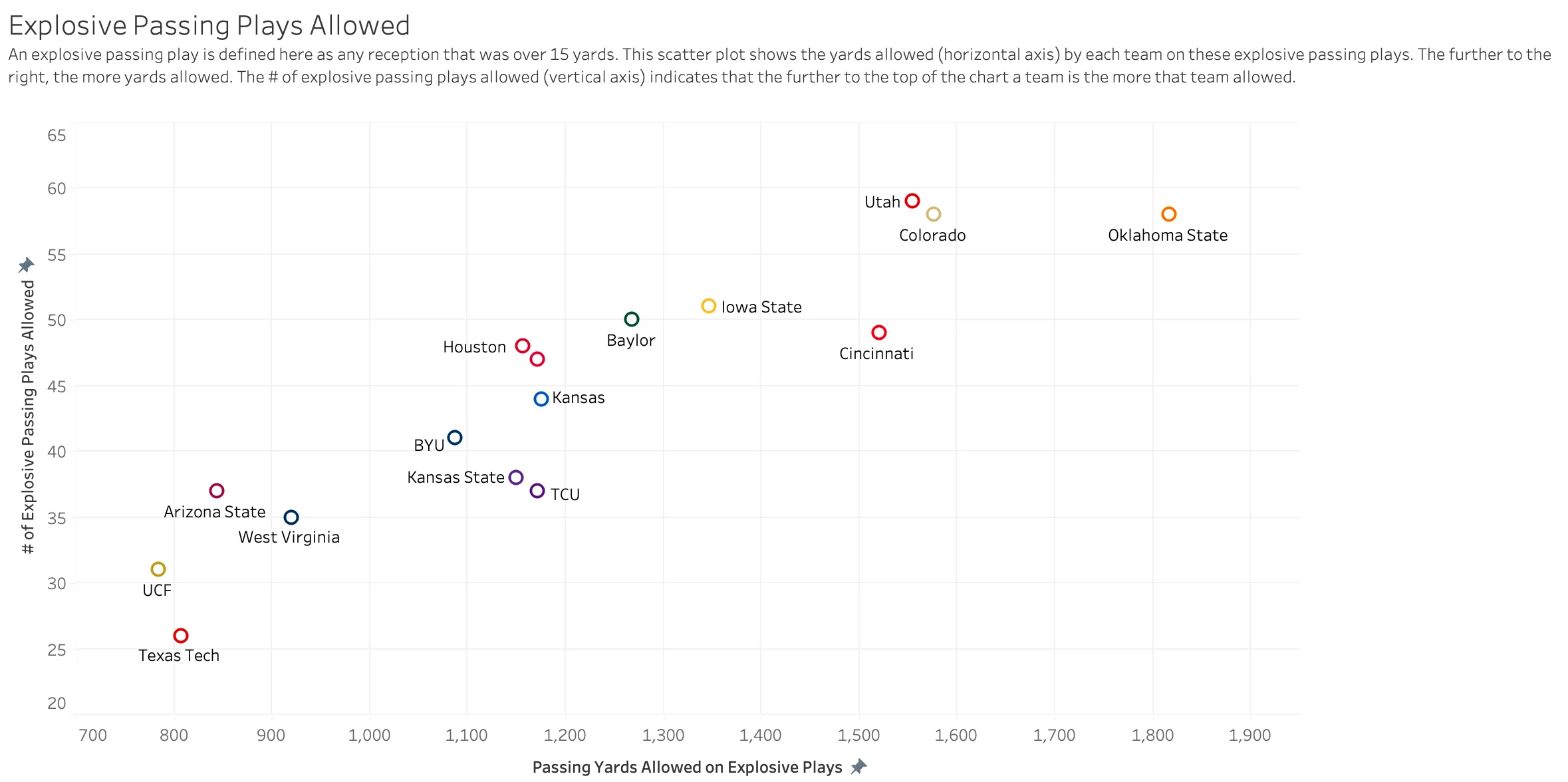
BYU was one of the better teams in of yards allowed on explosive passing plays when you look across the new Big 12 (measured by 2023 performance). BYU allowed 41 explosive passing plays and just under 1,100 yards total. What’s interesting to me is that Oklahoma State and Utah allowed nearly as many explosive passing plays as Colorado, but those teams were clearly better than the Buffaloes. Therefore, this metric cannot be examined in a vacuum.
Data come from @cfbfastR
Here are a few notes from this chart:
- Oklahoma State was the worst in the conference in total yards and still managed to find a way to the Big 12 title game
- Utah was surprisingly the worst team in volume, but the Utes and Cowboys show that you can’t look at this metric in a vacuum
- Case in point about not looking in a vacuum is Arizona State – they were the 3rd best in the conference in yards allowed and had the worst record of all 16 teams
Here are a couple of notes about BYU specifically:
- BYU was the 7th best in terms of # of explosive passing plays allowed in the Big 12
- BYU gave up the 5th least amount yards on explosive passing plays in the Big 12
- BYU gave up 5 to Cincinnati, 5 to TCU, and 4 to West Virginia
Once BYU faced off against Arkansas, they gave up explosive passing plays in every game they played from then on. When you start to look at what part of the game and down BYU typically gave up their explosive passing plays, you find the following takeaways:
- BYU gave up most of their explosive passing plays in the 2nd and 3rd quarters
- BYU gave up the most amount of explosive passing plays on 1st down
- BYU gave up the most amount of explosive passing yards on 3rd down
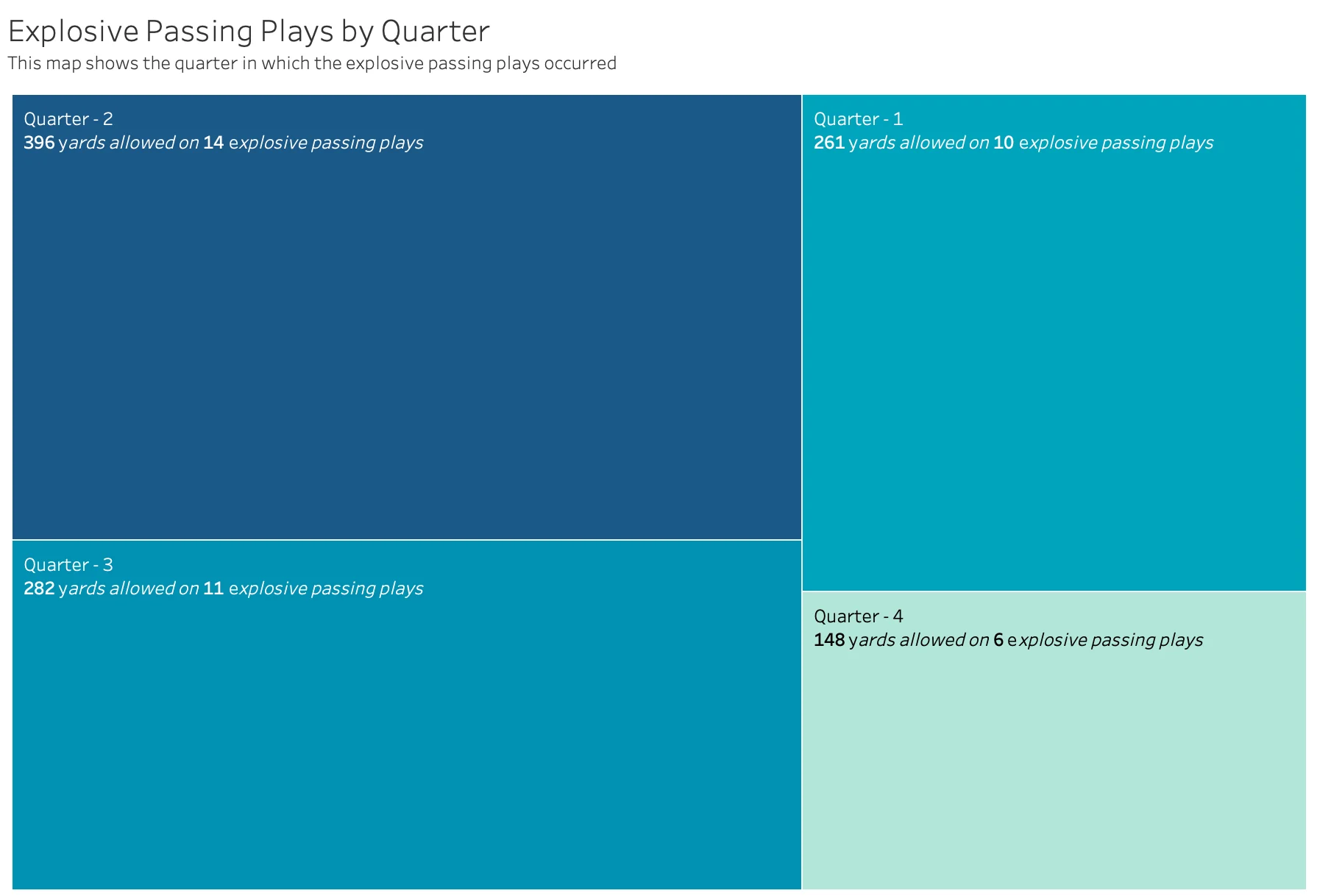
BYU gave up 396 yards on 14 explosive passing plays in the 2nd quarter during the 2023 season. In the first half total, the Cougars gave up 24 total explosive plays. That makes sense given they found themselves playing from behind for most of their games.
Data come from @cfbfastR
This next chart shows the explosive passing plays allowed by down.

BYU allowed 372 yards on 14 explosive plays on 1st down. That’s not lovely. Then, neither are the 400 yards allowed on 13 explosive passing plays on 3rd down. So, either from the start of the series or on a critical play when BYU needs a start, they were giving up these big plays.
Data come from @cfbfastR
How can BYU improve in explosive passing play defense? Well, again, broken record here. But, it starts with the defensive line. Then, it means tapping into a healthier and now more experienced secondary, particularly in the safety unit. Micah Harper’s return should help.
Last year’s injury woes could turn into this year’s experience gains. The likes of Tanner Wall, Ethan Slade, Raider Damuni, Crew Wakely, etc…all getting time should help this year.
#4 – Defensive Success Rate
This might be the most important metric here. So, you can say that I’m saving the best for last. The headline is that BYU needs to improve.
This is a more advanced stat that is not in a traditional box score. It’s actually quite understandable, but usually takes some explanation. I wrote about it last year when I wrote about BYU’s 2023 defensive line opportunities to improve.
In that case, I wrote about the defensive rushing success rate, but the metric is the same. You can measure defensive passing success rate, defensive rushing success rate, or total defensive success rate. The first measures success against defending the pass while the second measures success against defending the rush.
This is an efficiency metric that determines the success of a play. Successful plays meet one of the following criteria:
- the offense scored
- 1st downs which gain at least 50% of the yards to go
- 2nd downs which gain at least 70% of the yards to go
- 3rd and 4th downs which gain at least 100% of the yards to go
The lower the defense success rate, the better the defense as it was better at preventing offenses from successful plays that netted one of the bulleted results.
So, where did BYU perform last year?
BYU had a 43.2% defensive success rate. That means that on 43.2% of their defensive plays, they allowed one of those proceeding bullets to happen. That’s roughly equivalent to 5+ yards on 1st down and 3+ yards on 2nd down, and getting the first down on 3rd down.
Within the 2024 Big 12 teams, Colorado was the worst at 47%, and Utah was the best at 35.8%. Nationally, Stanford was the worst at 51.3% and Penn State was the best at 29.5%.
That tells you that BYU was worse than average. They were the 11th worst in the new Big 12.
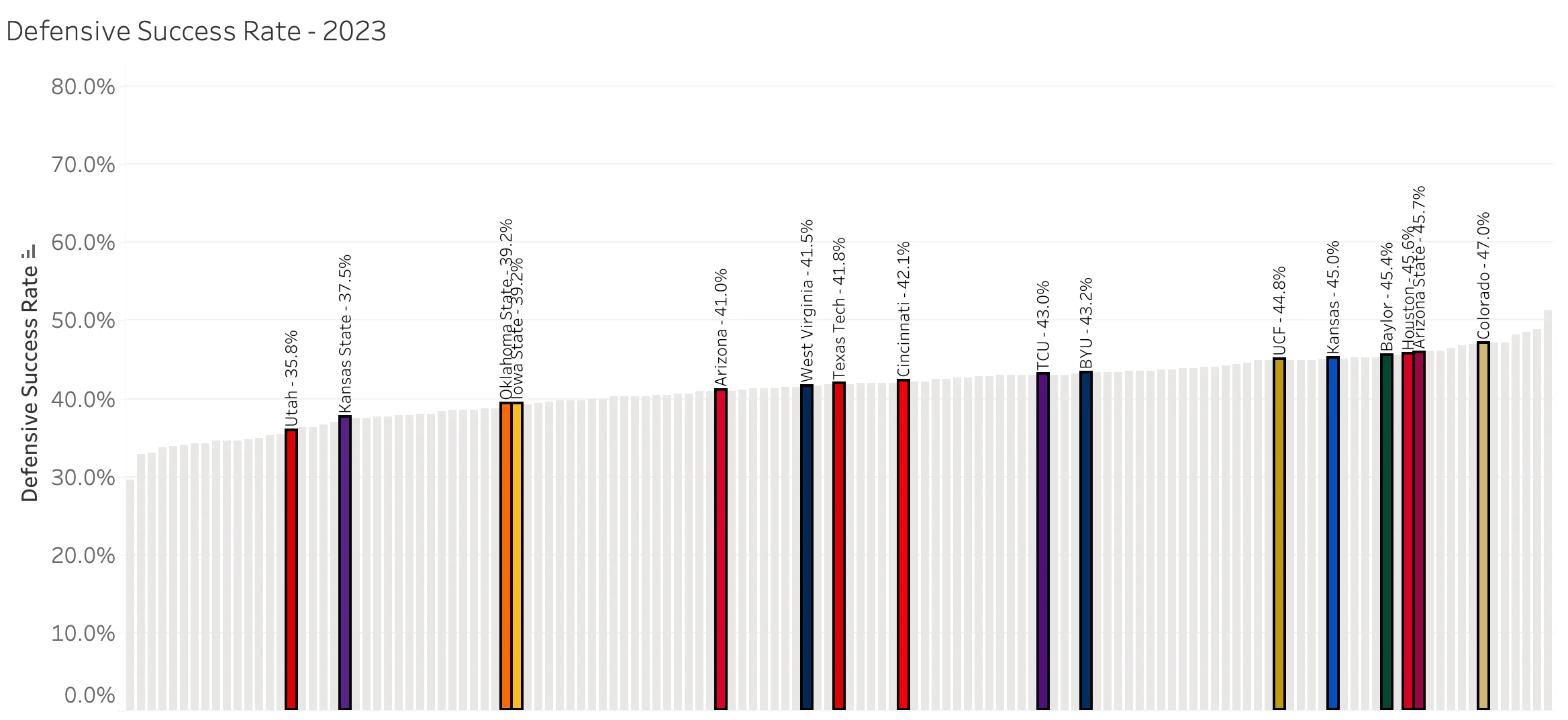
BYU was about middle of the pack with a 43.2% defensive success rate. That was good for 10th best in the new Big 12 during the 2023 season. They do have a clear opportunity to improve as they were not above the median in FBS.
Data come from @cfbfastR
How can BYU improve this? Well, let’s start with 1st down. BYU needs to get better at first down. That is where this metric, and any good defense, really makes a difference. If BYU improves in the other three preceding categories, then clearly this metric will see improvement.
BYU’s been seeing their cornerback position turn into a position of strength. They’ve started to recruit stronger talent that can better handle man coverage. Furthermore, they’ve also been developing their talent. This trend needs to continue because it allows for Jay Hill to be creative with his line backers while the defensive line continues to develop.
By the way, I wouldn’t expect the defensive line to storm out of the gate and that we’ll see night and day difference from last year. I do expect to see improvement, but I don’t expect BYU to turn into a Penn State defense. But, if there is one metric I want to see improve, it is this one here.
If you want to answer the question, “How can BYU improve in 2024?”, then it starts with the defensive line. And, then, it continues down the line (not literal line…). If they improve in their run defense and their pressure rates, then you will see this metric improve.
Will BYU improve in 2024?
Yes and no. You should see with your two good eyes the improvement on the defense. I’m confident in that. I’m not confident we will see the improvement in the record, and I’m not sure that we’ll see leaps and bounds of improvement in the stat sheet. The schedule is brutal, so BYU could play teams much tighter than last year and yet end up with a 4-8 record. Think about the 2024 season as a journey through Heartbreak City where the games are close and end in heart wrenching fashion.
I’m optimistic about the defense’s future for BYU in 2024 and beyond. I believe BYU will improve in 2024 and we’ll see a handful more sacks, slightly better defensive pressure rate and success rates.
I’m also confident that the Cougar Tails will also keep improving…if that is even possible.
Data come from @CfbFastR and Sports Reference
About 3rd Down Analysis (3DA): With a goal of fueling fan’s college football passion, 3rd Down Analysis brings an important combination of understanding the game of football while also knowing how to interpret what the data are telling us. Through long-form content, 3DA achieves this goal by dissecting data that is not easily accessible to fans and then sharing the bigger themes that are playing out on the field. Additionally, the business and financial background of the creator enables 3DA to share a unique viewpoint on the broader themes playing out across the college football landscape.
3rd Down Analysis has three primary content focus areas:
- BYU
- Big 12
- Current College Football big picture topics
If you have feedback, questions, content suggestions, or want to contribute, reach out to support@3rddownanalysis.com.
You can also search for the 3rd Down Analysis Podcast on Youtube, Apple Podcasts, or Spotify.


